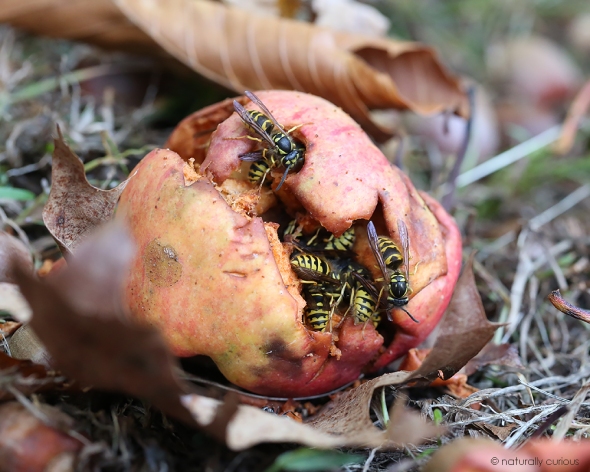Yellow Jackets On A Bender

At this time of year, yellow jackets, hornets and wasps take advantage of the plethora of fermented fruit that lies underneath fruit trees. Because the queen slows down the production of eggs in the fall, workers have time on their hands, as they have fewer larvae to collect food (chewed-up insects) for. Their life (but not the queen’s) is about to come to an end, and they go out in style. If you have observed these members of the Vespidae family acting more erratic, it may well be because they are drunk on hard cider. (Photo: yellow jackets binging)
White-margined Burrower Bugs Soon To Hibernate

White-margined Burrower Bugs (Sehirus cinctus) are true bugs, members of the order Hemiptera. The red and black bugs in this photograph are immature nymphs and have molted once. Their coloring serves as a warning to would-be predators that they are at the very least distasteful, and possibly poisonous. Adult White-margined Burrower Bugs are roughly ¼” long, and black with a white margin (not visible in photo) along the edges of their forewings.
These bugs feed on the seeds of plants in the mint and nettle families. Being true bugs, they feed not by chewing but by piercing seeds with a sharp beak, injecting digestive enzymes, and then sucking in the partially digested food.
White-margined Burrower Bugs are fairly unusual for non-social insects in that the mothers provide care and provisions for their young, much like social insects such as ants, paper wasps and honeybees. The adults dig shallow burrows into which they place a supply of seeds and lay between 120 and 150 eggs next to the seeds. They guard their eggs and brood and bring more seeds as needed for 1-3 days after the eggs hatch. At this point, the young bugs can forage for themselves.
Adults dig down into the leaf litter in late fall, where they overwinter and emerge next spring ready to mate. If you see a large cluster of White-margined Burrowers Beetles, do not be alarmed, as they do not bite nor are they interested in eating anything but species of mint and nettle.
Naturally Curious is supported by donations. If you choose to contribute, you may go to http://www.naturallycuriouswithmaryholland.wordpress.com and click on the yellow “donate” button.
Paper Wasp Queens Emerging From Hibernation
 Paper wasps have annual colonies – only the young, fertilized queens overwinter, with the old queen, female workers and the males all perishing in the fall. The queens seek shelter behind tree bark, or in rotting logs or stumps, and emerge in the spring when temperatures rise and day length is increasing. Last year’s nest is not re-used – the queen mixes wood and plant fiber with her saliva, creating several waterproof paper cells into each of which she lays an egg — the start of her future labor force. Due to the lack of wildflowers (and therefore nectar) this early in the spring, queens rely on the sap from broken tree branches, as well as the sap found in drilled Yellow-bellied Sapsucker wells, for sustenance.
Paper wasps have annual colonies – only the young, fertilized queens overwinter, with the old queen, female workers and the males all perishing in the fall. The queens seek shelter behind tree bark, or in rotting logs or stumps, and emerge in the spring when temperatures rise and day length is increasing. Last year’s nest is not re-used – the queen mixes wood and plant fiber with her saliva, creating several waterproof paper cells into each of which she lays an egg — the start of her future labor force. Due to the lack of wildflowers (and therefore nectar) this early in the spring, queens rely on the sap from broken tree branches, as well as the sap found in drilled Yellow-bellied Sapsucker wells, for sustenance.
Naturally Curious is supported by donations. If you choose to contribute, you may go to http://www.naturallycuriouswithmaryholland.wordpress.com and click on the yellow “donate” button.


















What Other Naturally Curious People Are Saying